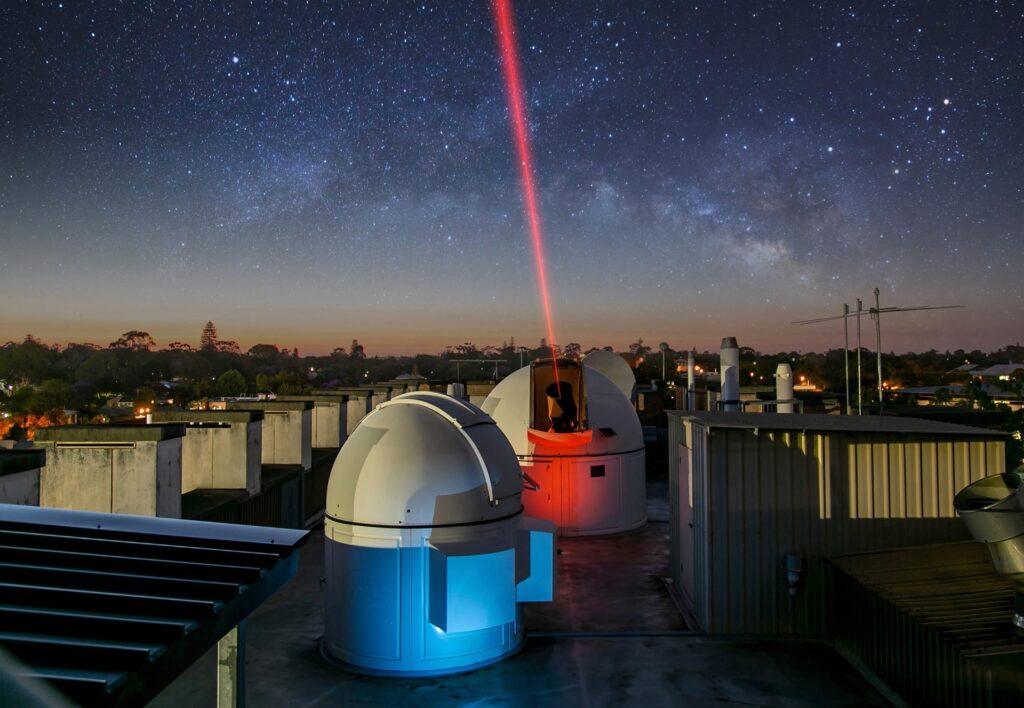UWA’s WA Optical Ground Station TeraNet 1. Courtesy of Daneil Obreshkov, International Space Centre
The University of Western Australia’s TeraNet, a network of optical ground stations specialising in high-speed space communications, has successfully received a laser signal from a German satellite in low Earth orbit, a breakthrough that paves the way for a 1,000-fold increase in communications bandwidth between space and Earth.
TeraNet’s laser communications test with OSIRISv1 marks the first step in replacing outdated radio systems with high-speed lasers for space communications in Western Australia. Funded by the Australian Government, the network aims to support diverse missions and enhance data transfer capabilities across multiple sectors.
Groundbreaking laser communications test
The TeraNet team, led by Associate Professor Sascha Schediwy from the UWA node at the International Centre for Radio Astronomy Research (ICRAR), received the laser signal from OSIRISv1, a laser communications payload from the German Aerospace Center’s (DLR) Institute of Communications and Navigation, which is mounted on the University of Stuttgart’s Flying Laptop satellite. The signal was detected using two TeraNet optical ground stations during the satellite’s flyby last Thursday.
“This demonstration is an important first step towards establishing a next-generation space communications network across Western Australia. The next step will be to connect this network to other optical ground stations currently being developed in Australia and around the world,” Associate Professor Shadiwe said.
Students working on the mobile optical communications network TeraNet 3. Courtesy of ICRAR
Advantages of lasers over radio in space communications
TeraNet ground stations use lasers instead of traditional radio signals to transfer data between satellites in space and users on Earth. Because lasers operate at much higher frequencies than radio, they can transfer data at speeds of thousands of gigabits per second, packing a lot more data into each second.
Associate Professor Sacha Shadiwi, leader of the Astrophotonics Group. Photo courtesy of ICRAR
Wireless communication technology has been used to communicate from space since the launch of the first satellite, Sputnik 1, nearly 70 years ago, and the technology has remained largely unchanged since then. As the number of satellites in space grows and the amount of data that new satellites can generate increases, significant bottlenecks are emerging in space when it comes to transmitting data back to Earth.
Overcoming Weather Challenges for Laser Communications
Laser communication is ideal for solving this problem, but has the drawback that laser signals can be interrupted by clouds and rain. The TeraNet team mitigates this drawback by building a network of three ground stations spread across Western Australia. This means that even if it’s cloudy at one ground station site, the satellite can still download data to another site with clear skies.
What’s more, one of two TeraNet ground stations that receive the satellite laser signals is mounted in the bed of a custom-built jeep truck, meaning it can be rapidly deployed to locations requiring ultra-fast space communications, such as remote areas where traditional communications links are cut off by natural disasters.
Impact on Earth and space activities
High-speed laser communications from space will revolutionize data transmission for Earth observation satellites, greatly strengthen and secure military communications networks, and enhance safe remote operations in areas such as autonomous mining operations and national disaster planning and response.
The ICRAR-based TeraNet team has been funded by the Australian Government, the Western Australian Government and UWA as part of the Australian Space Agency’s Moon to Mars Demonstrator Mission Grant Program for 2023. The $6.3 million project will support the construction of three TeraNet optical ground stations in Western Australia, providing in-kind access to an in-orbit satellite equipped with laser communications capability by the German Aerospace Center (DLR).
TeraNet’s network expansion and future goals
TeraNet will support multiple international space missions operating between low Earth orbit and the Moon, using both proven traditional optical communications standards and more advanced optical technologies such as deep space communications, ultra-high speed coherent communications, quantum secure communications, and optical positioning and timing.
The network consists of a ground station at UWA, a second ground station in the Mingenew Space District, 300km north of Perth, and a mobile ground station operated at the European Space Agency’s New Norcia facility.

